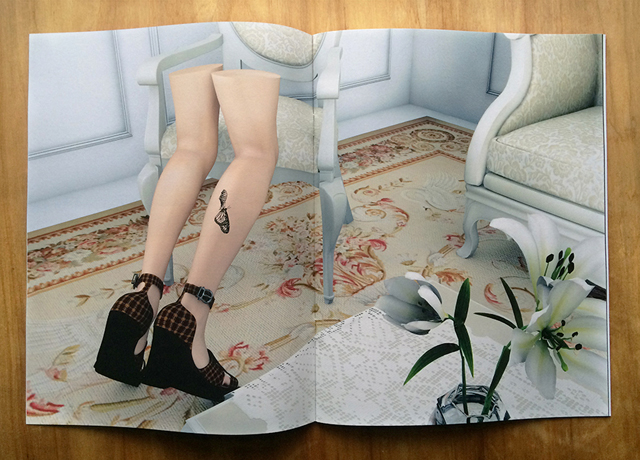A publication but also a two-person exhibition, the Gregory Kalliche-curated 57 Cell features an artist’s work as consumed and produced across interfaces. Image is representation, whether on paper or in pixels, and constructions also exist off-screen. This is where 57 Cell’s fourth print issue, launched on January 23 at LA’s ROGERS gallery, aligns itself so comfortably with its two presentations –.dream without loneliness by London-based Cristine Brache and DEFEATURIZED SPECIMEN by LA-based Ian Page –as it blurs distinctions between platforms.
The artists take seven pages each in the 14-page publication of computer-generated images presented in print with two front covers and no back in an egalitarian exploration of bodies, reproduction and objects in circulation. Brache’s ‘EXIT WOUNDS’ features three pairs of women’s legs, cut off at the waist and lounging in a bright white showroom with laced and feminised furniture. Only the odd butterfly tattoo and wedged or heeled foot accessory is there to interrupt the untouched purity of a scene that’s lit by lights and plunged into pitch-black darkness. The work title references the electrified objectification of the ‘Erotic Doll‘ of online wholesaler aliexpress.com in an accompanying text that reads “…pleasure constantly, as long as the battery, giving her power of love…” and employs an aesthetic specific to the Chinese-owned factories selling simulated persons for sex through a website.

Page, on the other hand, presents the objects used by humans to reproduce themselves in DEFEATURIZED SPECIMEN. Only the residue of their existence is present in the plastic vials of presumed semen, packed tightly in a makeshift cooling container that’s left open and exposed to the elements in stands made from polystyrene insulation with a picture of the Pink Panther and reading “ZERO OZONE DEPLETION”. A zoom in on the detail of the installation, under a rusty corrugated roof with solar panels, shows a low plastic picnic table with empty acrylic test tubes and instructions on how to fertilise an egg in a picture of a pipette and diagram of a cervix. There’s an empty Quaker Quick Oats container with “$ to help with Electric Bill THX !” Sex here becomes either clinical or utilitarian reproductive process, as in the detail of a cubicle for presumed deposits resembling an outhouse and featuring a children’s drawing of a parental euphemism for procreation in ‘STORK DELIVERS BABY’.

The materials listed under some of the works in Brache and Page’s respective catalogues present the animated images populating these computer-generated spaces as actual objects. They’re listed as “steel plastic lettering, LED lighting with power supply” for the depiction of the back of the chipboard backing of the well-lit facade of Brache’s ‘SIGNING THE BODY’. A glowing pink and purple sign screams “HOW AWESOME” above “I was calling my own name”, that on closer inspection hangs near a “china paint on bone china” that looks like a dog bowl. The full installation view of Page’s ‘STRAW BALE SPERM BANK’ includes “stucco, cinder blocks, LED rope, freezer compressor kit, straw, wood, plastic, polystyrene, donated semen in acrylic vials” except that these are things presented only through an image. It’s here that 57 Cell blurs the distinction between what is considered real and ‘unreal’. Where -like in Brache’s recent series of advertisements for contemporary Holy Water brand ‘Hi Girls Sleep Outside™‘ (images top right) –image begets life begets image begets art and so on. **
























